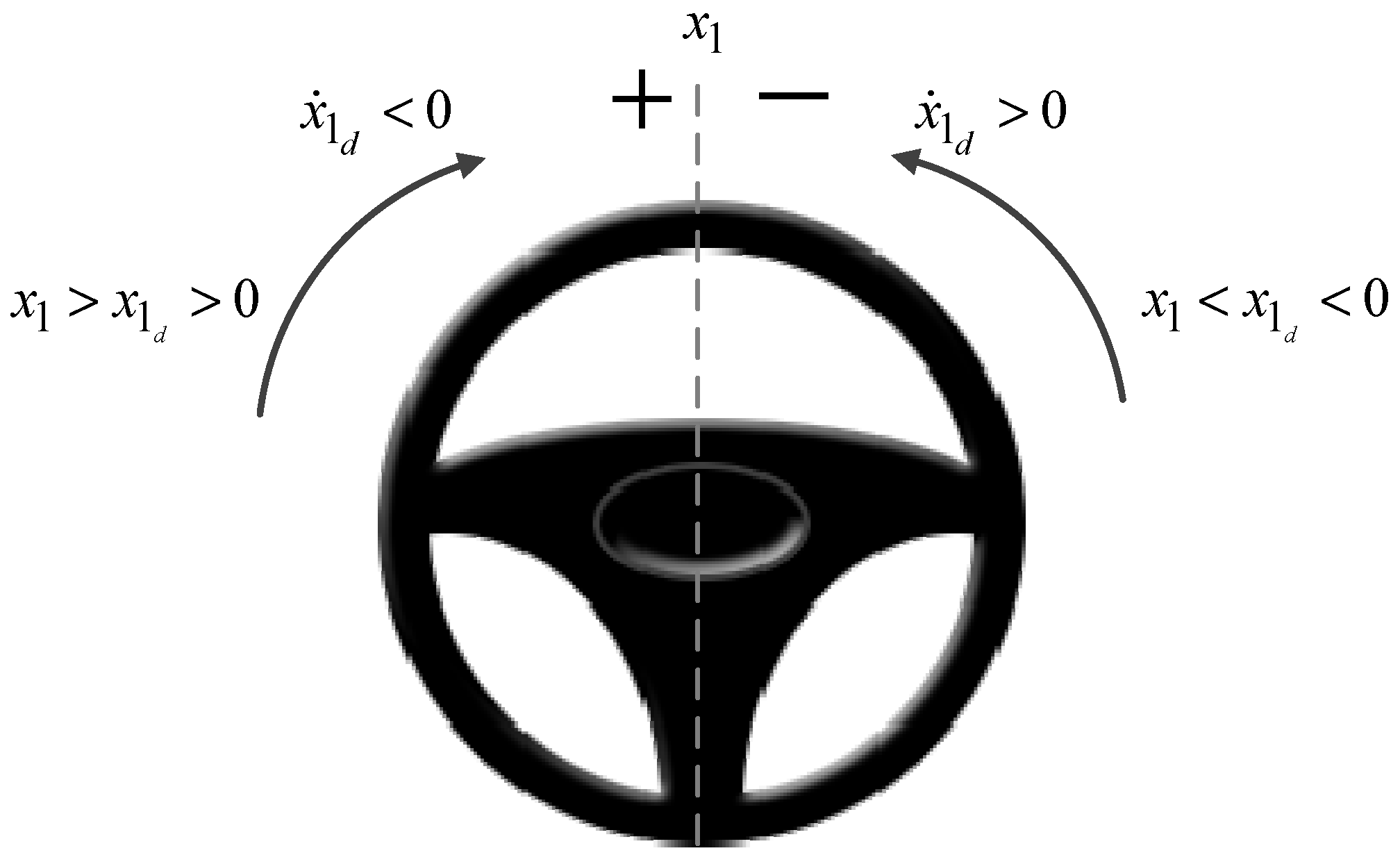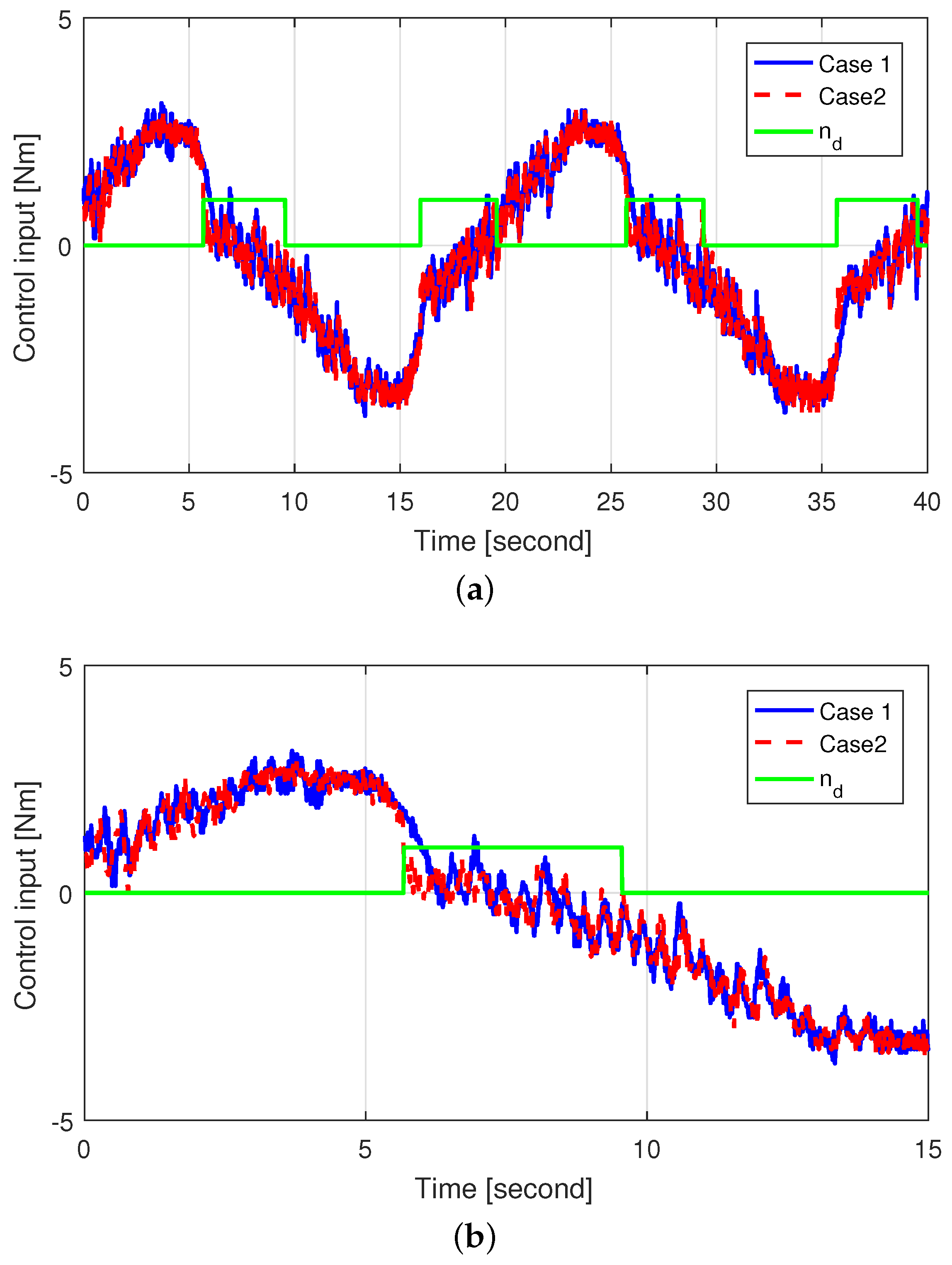Nonlinear Steering Wheel Angle Control Using Self-Aligning Torque with Torque and Angle Sensors for Electrical Power Steering of Lateral Control System in Autonomous Vehicles
Abstract
:1. Introduction
- Nonlinear damping using the self-aligning torque improves the SWA tracking performance and reduces the control input in the backstepping controller.
- An auxiliary state variable prevents using the measured signal derivative in the HGDOB.
- The performance of the proposed method is validated via EPS hardware-in-the-loop (HILS) simulation.
2. EPS System Model
3. High Gain Disturbance Observer
4. Backstepping Control Using Self-Aligning Torque
4.1. Backstepping Controller
4.2. SWA Control Using Self-Aligning Torque
5. Simulations and Experiments
5.1. Simulation Results
5.2. Experimental Results
- Case 1: Control without using the self-aligning torque, i.e.,
- Case 2: Control using the self-aligning torque, i.e., applying (32).
6. Conclusions
Author Contributions
Funding
Conflicts of Interest
Nomenclature
| Steering wheel angular position [deg] | |
| Desired steering wheel angular position [deg] | |
| Steering wheel angular velocity [deg/s] | |
| Motor angular position [deg] | |
| Motor angular velocity [deg/s] | |
| i | Current input of the motor [A] |
| T | Input torque of electric power steering system () [N·m] |
| Motor torque constant [N·m/A] | |
| Driver torque [N·m] | |
| Self-aligning torque [N·m] | |
| Steering column moment of inertia [Kg·m2] | |
| Steering column viscous damping [N·m/(rad/s)] | |
| Steering column stiffness [N·m/rad] | |
| Mass of the rack [kg] | |
| Viscous damping of the rack [N·m/(rad/s)] | |
| Steering column pinion radius [m] | |
| Tire spring rate [N/m] | |
| Motor moment of inertia [kg·m2] | |
| Motor shaft viscous damping [N·m/(rad/s)] | |
| Longitudinal velocity [Km/h] |
References
- Cai, L.; Rad, A.B.; Chan, W.-L. An intelligent longitudinal controller for application in semiautonomous vehicles. IEEE Trans. Ind. Electron. 2010, 59, 1487–1497. [Google Scholar]
- Chen, Y.; Wang, J. Adaptive vehicle speed control with input injections for longitudinal motion independent road frictional condition estimation. IEEE Trans. Veh. Technol. 2011, 60, 839–948. [Google Scholar] [CrossRef]
- Hedrick, J.K.; Tomizuka, M.; Varaiya, P. Control issues in automated highway systems. IEEE Control Syst. Mag. 1994, 50, 356–364. [Google Scholar]
- Antony, W.B. Innovation drivers for electric power-assisted steering. IEEE Control Syst. Mag. 2003, 23, 30–39. [Google Scholar]
- Raksincharoensak, P.; Nagai, M.; Shino, M. Lane keeping control strategy with direct yaw moment control input by considering dynamics of electric vehicle. Veh. Syst. Dyn. 2006, 44, 192–201. [Google Scholar] [CrossRef]
- Hu, C.; Wang, R.; Yan, F.; Huang, Y.; Wang, H.; Wei, C. Differential steering based yaw stabilization using ISMC for independently actuated electric vehicles. IEEE Trans. Intell. Transp. Syst. 2018, 19, 627–639. [Google Scholar] [CrossRef]
- Huang, C.; Naghdy, F.; Du, H. Observer-based fault tolerant controller for uncertain steer-by-wire systems using the delta operator. IEEE/ASME Trans. Mechatron. 2018. [Google Scholar] [CrossRef]
- Taylor, C.J.; KoSeckd, J.; Blasi, R.; Malik, J. A comparative study of vision-based lateral control strategies for autonomous highway driving. Int. J. Robot. Res. 1999, 18, 442–453. [Google Scholar] [CrossRef]
- Chaib, S.; Netto, M.S.; Mammar, S. H∞, adaptive, PID and fuzzy control: A comparison of controllers for vehicle lane keeping. In Proceedings of the IEEE Intelligent Vehicles Symposium, Parma, Italy, 14–17 June 2004. [Google Scholar]
- Talvala, L.R.K.; Kritayakirana, K.; Gerdes, J.C. Pushing the limits: From lanekeeping to autonomous racing. Annu. Rev. Control 2011, 35, 137–148. [Google Scholar] [CrossRef]
- Son, Y.S.; Kim, W.; Lee, S.-H.; Chung, C.C. Robust multi-rate control scheme with predictive virtual lanes for lane-keeping system of autonomous highway driving. IEEE Trans. Veh. Technol. 2015, 64, 3378–3391. [Google Scholar] [CrossRef]
- Han, G.; Fu, W.; Wang, W.; Wu, Z. The lateral tracking control for the intelligent vehicle based on adaptive PID neural network. Sensors 2017, 17, 1244. [Google Scholar] [CrossRef] [PubMed]
- Liu, Q.; Liu, Y.; Liu, C.; Chen, B.; Zhang, W.; Li, L.; Ji, X. Hierarchical lateral control scheme for autonomous vehicle with uneven time delays induced by vision sensors. Sensors 2018, 18, 2544. [Google Scholar] [CrossRef] [PubMed]
- Latrech, C.; Chaibet, A.; Boukhnifer, M.; Glaser, S. Integrated longitudinal and lateral networked control system design for vehicle platooning. Sensors 2018, 18, 3085. [Google Scholar] [CrossRef] [PubMed]
- Morton, C.; Spargo, C.M.; Pickert, V. Electrified hydraulic power steering system in hybrid electric heavy trucks. IET Electr. Syst. Transp. 2014, 4, 70–77. [Google Scholar] [CrossRef] [Green Version]
- Yang, T. A new control framework of electric power steering system based on admittance control. IEEE Trans. Control Syst. Technol. 2015, 23, 762–769. [Google Scholar] [CrossRef]
- Du, P.-P.; Su, H.; Tang, G.-Y. Active Return-to-Center Control Based on Torque and Angle Sensors for Electric Power Steering Systems. Sensors 2018, 18, 855. [Google Scholar] [CrossRef]
- Parmar, M.; Hung, J.Y. A sensorless optimal control system for an automotive electric power assist steering system. IEEE Trans. Ind. Electron. 2004, 51, 290–298. [Google Scholar] [CrossRef]
- Chen, X.; Yang, T.; Chen, X.; Zhou, K. A generic model-based advanced control of electric power-assisted steering systems. IEEE Trans. Control Syst. Technol. 2008, 16, 1289–1300. [Google Scholar] [CrossRef]
- Marouf, A.; Djemai, M.; Sentouh, C.; Pudlo, P. A new control strategy of an electric-power-assisted steering system. IEEE Trans. Veh. Technol. 2012, 61, 3574–3589. [Google Scholar] [CrossRef]
- Sugita, S.; Tomizuka, M. Cancellation of unnatural reaction torque in variable-gear-ratio. ASME J. Dyn. Syst. Meas. Control 2012, 134, 021019. [Google Scholar] [CrossRef]
- Kim, W.; Son, Y.S.; Chung, C.C. Torque overlay-based robust steering wheel angle control of electrical power steering for a lane-keeping system of automated vehicles. IEEE Trans. Veh. Technol. 2016, 65, 4379–4392. [Google Scholar] [CrossRef]
- Lin, F.-J.; Chen, S.-G.; Sun, I.-F. Intelligent sliding-mode position control using recurrent wavelet fuzzy neural network for electrical power steering system. Int. J. Fuzzy Syst. 2017, 19, 1344–1361. [Google Scholar] [CrossRef]
- Homann, A.; Bufi, M.; Keller, M.; Glander, K.-H.; Bertram, T. Experimental identification of torque overlay steering system and nonlinear control. IFAC PapersOnLine 2018, 51, 311–316. [Google Scholar] [CrossRef]
- Kim, J.-H.; Song, J.-B. Control logic for an electric power steering system using assist motor. Mechatronics 2002, 12, 447–459. [Google Scholar] [CrossRef]
- Christopher, M.; Pickert, V.; Armstrong, M. Self-alignment torque as a source of energy recovery for hybrid electric trucks. IEEE Trans. Veh. Technol. 2014, 63, 62–71. [Google Scholar]
- Chen, W.; Ballance, D.; Gawthrop, P.; O’Reilly, J. A nonlinear disturbance observer for robotic manipulators. IEEE Trans. Ind. Electron. 2000, 47, 932–938. [Google Scholar] [CrossRef] [Green Version]








© 2018 by the authors. Licensee MDPI, Basel, Switzerland. This article is an open access article distributed under the terms and conditions of the Creative Commons Attribution (CC BY) license (http://creativecommons.org/licenses/by/4.0/).
Share and Cite
Kim, W.; Kang, C.M.; Son, Y.-S.; Chung, C.C. Nonlinear Steering Wheel Angle Control Using Self-Aligning Torque with Torque and Angle Sensors for Electrical Power Steering of Lateral Control System in Autonomous Vehicles. Sensors 2018, 18, 4384. https://doi.org/10.3390/s18124384
Kim W, Kang CM, Son Y-S, Chung CC. Nonlinear Steering Wheel Angle Control Using Self-Aligning Torque with Torque and Angle Sensors for Electrical Power Steering of Lateral Control System in Autonomous Vehicles. Sensors. 2018; 18(12):4384. https://doi.org/10.3390/s18124384
Chicago/Turabian StyleKim, Wonhee, Chang Mook Kang, Young-Seop Son, and Chung Choo Chung. 2018. "Nonlinear Steering Wheel Angle Control Using Self-Aligning Torque with Torque and Angle Sensors for Electrical Power Steering of Lateral Control System in Autonomous Vehicles" Sensors 18, no. 12: 4384. https://doi.org/10.3390/s18124384
APA StyleKim, W., Kang, C. M., Son, Y.-S., & Chung, C. C. (2018). Nonlinear Steering Wheel Angle Control Using Self-Aligning Torque with Torque and Angle Sensors for Electrical Power Steering of Lateral Control System in Autonomous Vehicles. Sensors, 18(12), 4384. https://doi.org/10.3390/s18124384





